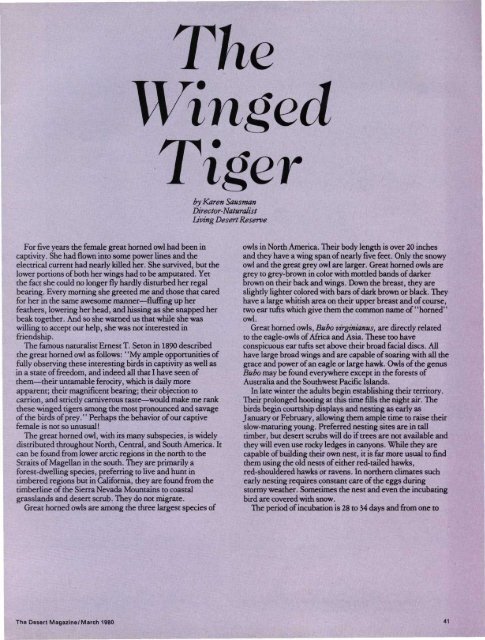BYWAYS PLUS: DATES! - Desert Magazine of the Southwest
BYWAYS PLUS: DATES! - Desert Magazine of the Southwest
BYWAYS PLUS: DATES! - Desert Magazine of the Southwest
You also want an ePaper? Increase the reach of your titles
YUMPU automatically turns print PDFs into web optimized ePapers that Google loves.
For five years <strong>the</strong> female great horned owl had been in<br />
captivity. She had flown into some power lines and <strong>the</strong><br />
electrical current had nearly killed her. She survived, but <strong>the</strong><br />
lower portions <strong>of</strong> both her wings had to be amputated. Yet<br />
<strong>the</strong> fact she could no longer fly hardly disturbed her regal<br />
bearing. Every morning she greeted me and those that cared<br />
for her in <strong>the</strong> same awesome manner—fluffing up her<br />
fea<strong>the</strong>rs, lowering her head, and hissing as she snapped her<br />
beak toge<strong>the</strong>r. And so she warned us that while she was<br />
willing to accept our help, she was not interested in<br />
friendship.<br />
The famous naturalist Ernest T. Seton in 1890 described<br />
<strong>the</strong> great horned owl as follows:' 'My ample opportunities <strong>of</strong><br />
fully observing <strong>the</strong>se interesting birds in captivity as well as<br />
in a state <strong>of</strong> freedom, and indeed all that I have seen <strong>of</strong><br />
<strong>the</strong>m—<strong>the</strong>ir untamable ferocity, which is daily more<br />
apparent; <strong>the</strong>ir magnificent bearing; <strong>the</strong>ir objection to<br />
carrion, and strictly carniverous taste—would make me rank<br />
<strong>the</strong>se winged tigers among die most pronounced and savage<br />
<strong>of</strong> <strong>the</strong> birds <strong>of</strong> prey.'' Perhaps <strong>the</strong> behavior <strong>of</strong> our captive<br />
female is not so unusual!<br />
The great horned owl, with its many subspecies, is widely<br />
distributed throughout North, Central, and South America. It<br />
can be found from lower arctic regions in <strong>the</strong> north to <strong>the</strong><br />
Straits <strong>of</strong> Magellan in die soudi. They are primarily a<br />
forest-dwelling species, preferring to live and hunt in<br />
timbered regions but in California, diey are found from <strong>the</strong><br />
timberline <strong>of</strong> <strong>the</strong> Sierra Nevada Mountains to coastal<br />
grasslands and desert scrub. They do not migrate.<br />
Great horned owls are among <strong>the</strong> three largest species <strong>of</strong><br />
The<br />
Winged<br />
Tiger<br />
by Karen Sausman<br />
Director-Naturalist<br />
Living <strong>Desert</strong> Reserve<br />
owls in North America. Their body lengdi is over 20 inches<br />
and <strong>the</strong>y have a wing span <strong>of</strong> nearly five feet. Only die snowy<br />
owl and die great grey owl are larger. Great horned owls are<br />
grey to grey-brown in color widi mottled bands <strong>of</strong> darker<br />
brown on dieir back and wings. Down die breast, diey are<br />
slightly lighter colored with bars <strong>of</strong> dark brown or black. They<br />
have a large whitish area on dieir upper breast and <strong>of</strong> course,<br />
two ear tufts which give diem die common name <strong>of</strong>' 'horned''<br />
owl.<br />
Great horned owls, Bubo virginianus, are directly related<br />
to die eagle-owls <strong>of</strong> Africa and Asia. These too have<br />
conspicuous ear tufts set above <strong>the</strong>ir broad facial discs. All<br />
have large broad wings and are capable <strong>of</strong> soaring widi all die<br />
grace and power <strong>of</strong> an eagle or large hawk. Owls <strong>of</strong> <strong>the</strong> genus<br />
Bubo may be found everywhere except in die forests <strong>of</strong><br />
Australia and die Soudiwest Pacific Islands.<br />
In late winter die adults begin establishing dieir territory.<br />
Their prolonged hooting at diis time fills die night air. The<br />
birds begin courtship displays and nesting as early as<br />
January or February, allowing diem ample time to raise dieir<br />
slow-maturing young. Preferred nesting sites are in tall<br />
timber, but desert scrubs will do if trees are not available and<br />
diey will even use rocky ledges in canyons. While diey are<br />
capable <strong>of</strong> building dieir own nest, it is far more usual to find<br />
diem using die old nests <strong>of</strong> eidier red-tailed hawks,<br />
red-shouldered hawks or ravens. In nor<strong>the</strong>rn climates such<br />
early nesting requires constant care <strong>of</strong> die eggs during<br />
stormy weadier. Sometimes die nest and even die incubating<br />
bird are covered widi snow.<br />
The period <strong>of</strong> incubation is 28 to 34 days and from one to<br />
The <strong>Desert</strong> <strong>Magazine</strong>/March 1980 41
















